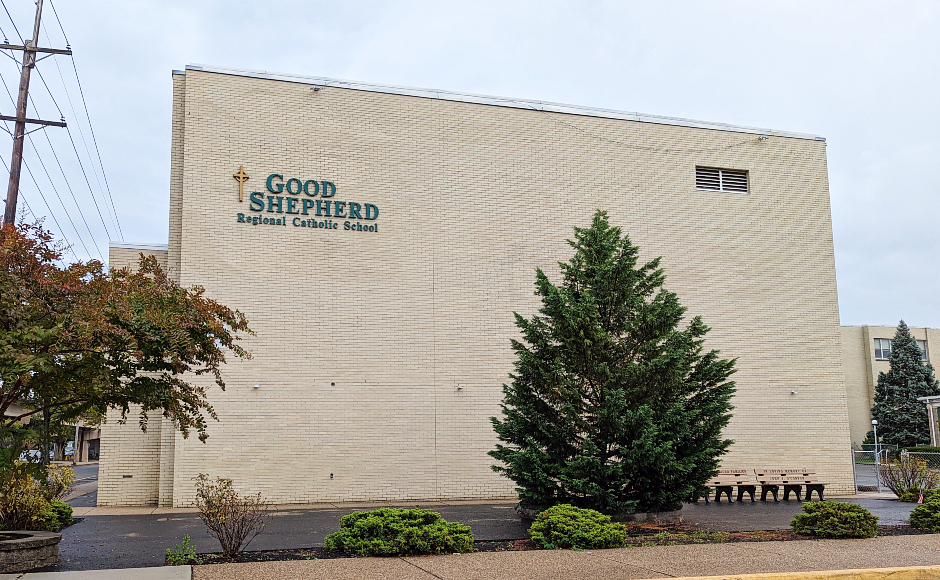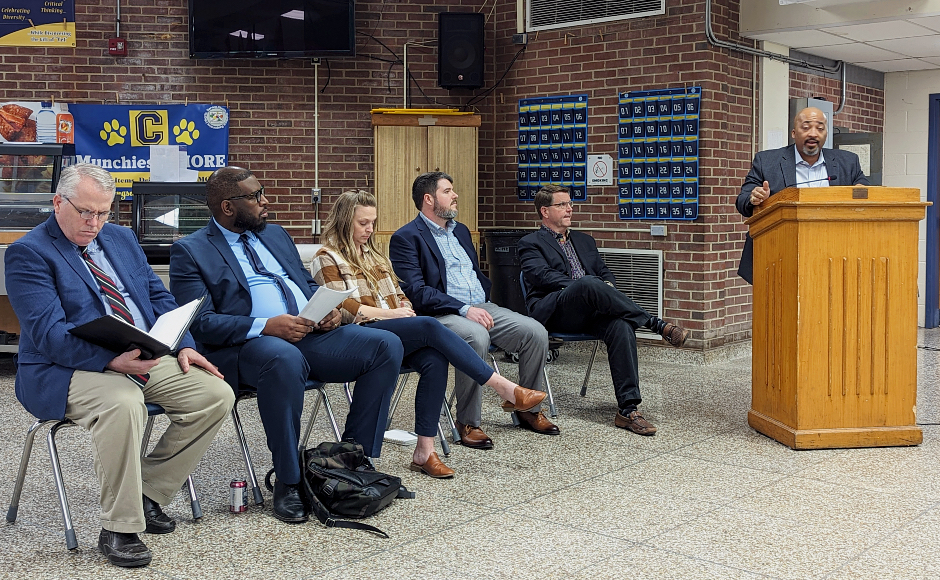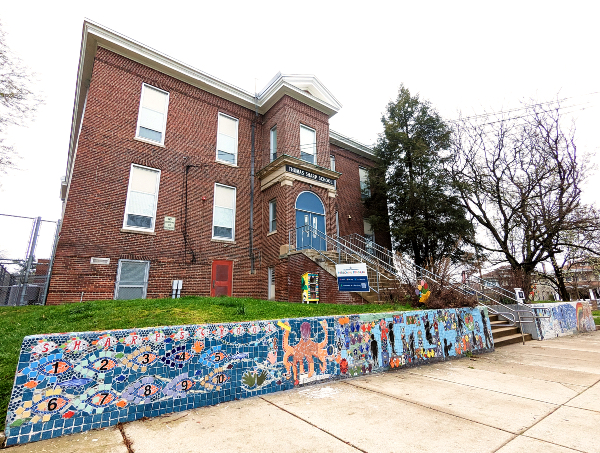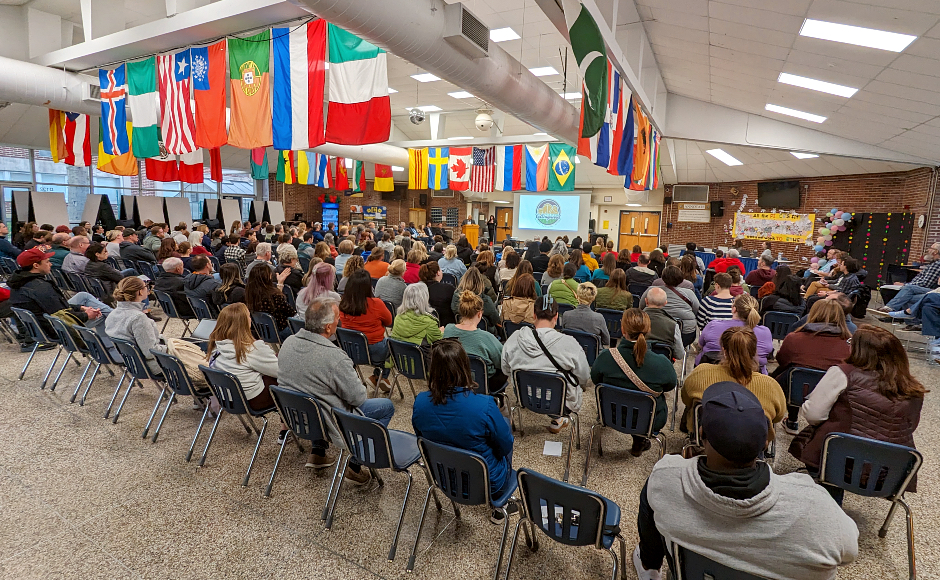
In March 2024, Collingswood Schools introduced a $45-million bond referendum to a packed house. Credit: Matt Skoufalos.
Ahead of a planned September referendum on a $44.5-million school bond measure, Collingswood Board of Education leaders recently fielded an unsolicited, alternative proposal from the borough municipal government in the form of a letter from Mayor Jim Maley.
Distilled, its message is: “Call off the bond vote, and let us buy Good Shepherd Regional Catholic School.”
In full, its criticisms of the school board extend from its approach to the bond referendum, to its handling of teacher contracts, alleging that the current decisions are deepening social divisions in the community.
The letters themselves came to light after they were posted anonymously on local social media groups. Their contents illustrate two local governing bodies that seem far apart on how to manage the financial and community responsibilities inherent in their respective roles.
“While we agree with all the goals the bond referendum sets, we are very concerned about the current process,” Maley wrote on behalf of all three borough commissioners in a July 2 letter to the Collingswood Board of Education.
“Trying to pass the largest construction bond in Borough history while closing two elementary schools for the first time and managing the post-pandemic budget crunch is leading to deep divisions in our community,” he continued. “Layoffs and the teacher’s contract impasse have only intensified these divisions.
“We believe that with time and public engagement, we can achieve our common objectives of better education quality, improved engagement, teacher retention and attraction, and appropriate facilities to meet the needs of students now and into the future,” Maley wrote.
“We fear that an election result, regardless of the outcome, will only deepen the divisions and continue to hinder our common goals.”
Instead, the commissioners suggest that the borough could acquire Good Shepherd, holding it for future use by the district, while subsequently, “collaboratively facilitat[ing] a community engagement process to evaluate the use of school facilities” for recreation and the arts — a process that both entities began last year.
In exchange, the commissioners ask the board to suspend the bond referendum, considering instead an operations referendum “to address teacher retention, salary guide, class times, and other current operations issues without constraint by the State cap.”
“We do not make this proposal lightly,” Maley wrote. “We understand some may see it as Borough interference in the schools, but please know that is not our intention. We are not interested in controlling education choices and decisions. However, schools are the most important fabric binding our community, and recent months have shown how a tear in that fabric can unravel an entire community.”
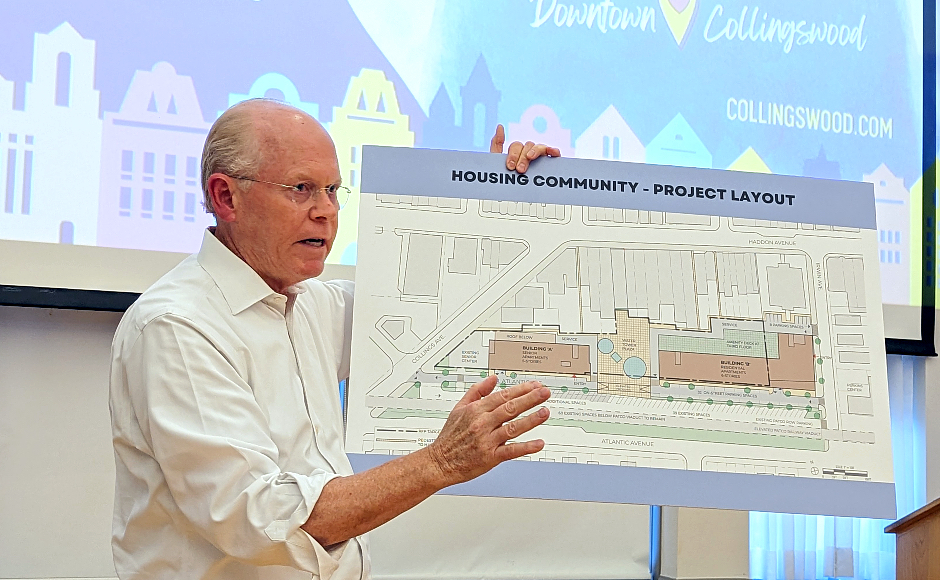
Collingswood Mayor Jim Maley discusses a local redevelopment project in June 2024. Credit: Matt Skoufalos.
‘It’s a really emotional process’
Asked to expound on the ideas contained within the correspondence, the mayor told NJ Pen that borough commissioners support the aims of the referendum but question the process underpinning it.
He said the offer to buy the school and hold it would give the district time to reconsider its approach.
“Everybody thinks the goals are good, but this process, because it’s going so fast, it’s really complicated stuff; it’s dividing people,” Maley said. “We do not feel it’s headed in a good direction.
“It’s a really emotional process,” he said. “They have it under contract at $1.4M. We could take that out of the equation. They would still have to raise the money to buy it, but it relieves the time pressure of not losing the school.”
The parcel is already zoned as a school, and any other buyer would have to first convince the Catholic Diocese of Camden to sell it off for some other purpose. Moreover, Maley pointed out that, within the past three years, the borough has already shot down one proposal that would have replaced the church and school with some 50 to 70 apartment units.
“[An applicant] could always come in for a use variance, but there’s no indication that that’s happened,” he said. “We already told them once we’re not changing the zoning. It’s a school.”
The mayor took a dim view of the public process behind the referendum, alleging that some school board members were ignorant of the proposal presented to the public until the last minute. He criticized the board for developing the plan within its ad hoc facilities committee rather than in a broader public process.
“I don’t get focus groups; I don’t get small, invited groups,” Maley said. “We did more public meetings to build a police and fire station than they did to close two elementary schools. They didn’t even tell all the members of the Board that that plan existed until a day before the public meeting.”
The Board of Education is not obligated to confer with the municipal government in the development of its bond referenda, and Maley said that in 2018, the last board to submit a bond question “did not engage us in preparing for that either.
“They obviously don’t have to; they can do it all without us,” he said. “But I view it as more that we’re part of that public engagement. If we don’t know what the plan is, and it comes as a surprise to us, it’s a surprise to everyone in the borough.
“If I try to sell something to people, I go through a process, and that’s not what happened,” the mayor said. “It takes a lot longer and it has to have a different format than what they’re doing.”
Maley was also adamant that the Board of Education could instead pursue a public ballot question to permanently exceed the 2 percent budget cap to close its operational shortfall.
He cited a March 12 public question in Robbinsville, where voters passed a $2.75-million permanent increase to their school taxes to maintain staffing, busing, and extracurriculars after having previously voted down a larger referendum for the same purpose.
“There is no legal impediment to Collingswood doing it,” the mayor said.
Asked to explain his written remark that the referendum process was “leading to deep divisions” in the borough, Maley cited publicly raised concerns about racial disparities within a school district that has reckoned with high-profile racial incidents in its recent past. Conversations about equity also have pointed to student achievement gaps amid the uneven distribution of ethnic minority students in Collingswood elementary schools.
But the mayor’s letter also suggested that even if the referendum passed, social divisions within the community would be deepened.
“The whole race element that’s woven through parts of this has got people calling each other some pretty nasty things,” Maley said. “That process and what that does in dividing, I think that could be eased.”
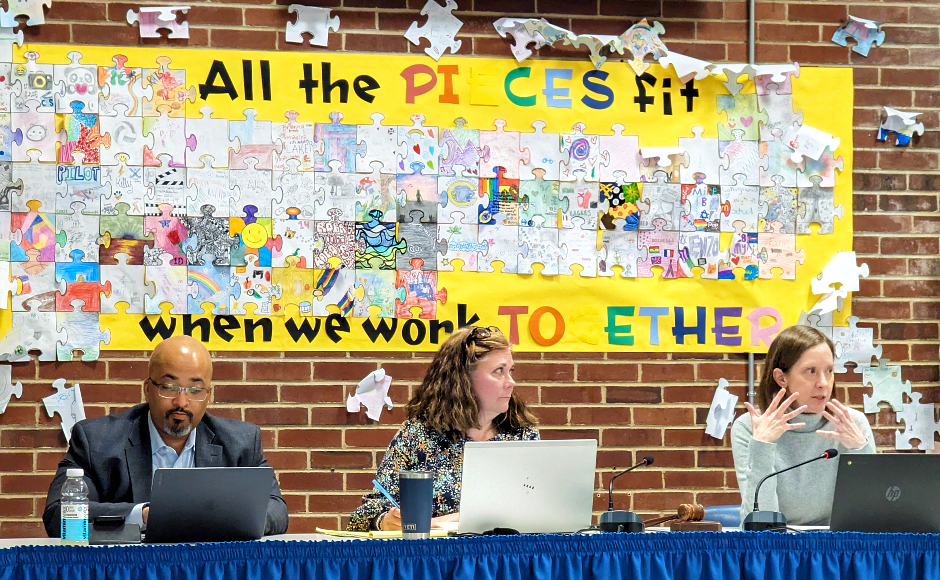
Collingswood BOE President Regan Kaiden (right), Business Administrator Bethann Coleman (center) and Superintendent Fred McDowell at a March 28, 2024 Collingswood School Board meeting. Credit: Matt Skoufalos.
‘A diversity of opinions on how to address the challenges that face our schools’
The Board of Education wasn’t interested in the mayor’s proposal, and when the two sides sat down for an in-person meeting July 11, provided Maley with its own letter.
Its response, written by Board of Education President Regan Kaiden on behalf of the board, outlined the evaluation process whereby the district professionals, Garrison Architects and Remington and Vernick Engineers, “painstakingly assessed” the borough elementary schools by current condition, compliance with disability regulations, and cost to renovate.
“The reports indicate that elementary school students in Collingswood attend school in buildings that, despite the efforts of our excellent Buildings and Grounds staff, do not have the capacity to serve them well,” Kaiden wrote.
“These buildings are small and very old; some are over 100 years old. All but one elementary school lacks full ADA compliance. Full renovations of some of these schools would exceed our district’s borrowing capacity,” she wrote, expounding further on the deteriorated conditions of the district athletic facilities.
“Despite these less than ideal conditions, Collingswood has not made a significant investment in its schools’ facilities in 20 years,” Kaiden’s letter continues. “We simply cannot ask our students and their families to wait any longer.”
The Board made its own counter-offer to borough commissioners, inviting the municipality to acquire James A. Garfield Elementary School and lead its redevelopment; provide student shuttles as a community benefit; and partner with the district to redevelop Thomas A. Sharp Elementary School as a recreational space.
“In an evolving community like Collingswood, there is bound to be a diversity of opinions on how to address the challenges that face our schools,” Kaiden wrote. “We do not discount these differences; to the contrary, we believe that all members of our community deserve a say in the direction our school district takes.
“We do not believe that delaying a vote on an investment in our school facilities will “solve” the problem of division,” she continued.
“Instead, a democratic process — a vote — will empower our community to tell its elected officials what they want for their children and their schools. We look forward to hearing from our community on September 17.”
Kaiden challenged a number of Maley’s assertions about the board’s due diligence process, its willingness to seek partnership with the municipal government, and the feasibility of deferring the bond question away from the referendum process.
“I think it’s a disappointing stance that our mayor is taking for someone who wants partnership,” she said. “I would never, as a school board president, wade into the fray on any borough land development issue — which, I admit, is not my area of expertise.
“I would not give my opinions, nor would I deign to suggest that the borough isn’t doing their due diligence to them or to anyone else.”
‘The community deserves a vote’
Kaiden said that the school board and district leaders have met with the borough about its plan to acquire Good Shepherd as far back as 2021, and that its normal process for capital improvement questions is to develop a plan in committee before presenting details to the broader board membership.
Collingswood Public Schools first introduced the idea of acquiring Good Shepherd in a public meeting September 12, 2022, a year-and-a-half before introducing its capital project in a special meeting March 26, 2024.
Kaiden said she personally e-mailed Maley ahead of that presentation “so it wasn’t a complete shock to him.
“The opportunity for the mayor to be given all the information in one take in advance of the public meeting was provided to him,” Kaiden said.
Moreover, she challenged Maley’s allegation that the board was not itself communicating with membership, noting that the board membership held a full retreat March 9, 2024, at which the referendum plan was discussed in great depth ahead of presenting it to the public later that month.
District officials say that only two board members, Mary Saverino of Collingswood, and Christopher Dilkus of Woodlynne, did not attend that retreat.
Thereafter, public meetings about the bond referendum included information sessions in April and July; the district has also fielded feedback and questions about the project at its regular board meetings, which are open to the public.
Kaiden suggested that the problem isn’t a lack of communication on the issue, or a lack of awareness about the referendum or its aims. Instead, she said the process is simply a thorny and emotional one because it’s pointing to the possibility of uncomfortable change.
However, subverting the vote because the choice is conflicted lends neither clarity to the process nor resolves the discomfort underpinning it.
“I don’t think that, at this late of a date, coming to the table and not letting the community have their say is the way to go,” Kaiden said. “We’ve told the community we’re going to do this. They’re expecting it. They deserve a vote. We shouldn’t make that decision for them in back-and-forth letters or meetings with the borough.
“I don’t believe that the fabric of the town is being torn apart,” she said. “I think I’ve seen a lot of people come together over issues, and want to stand up for each other and for groups [of people].
“Everything is so nuanced, and everything is so complicated, and pretending that it isn’t is probably what makes things frustrated,” Kaiden said. “It doesn’t mean anything’s nefarious, it just means it’s complicated.”
Collingswood School Board Vice-President Matt Craig said he was frustrated not only by the nature of the conversation, but that the letters had been leaked to the public.
It’s not the first time this board has had the issue: earlier this spring, the confidential details of Superintendent Fredrick McDowell’s contract were posted on social media ahead of a board vote. At that time, the district regarded it as an ethics violation; Craig took a similar view of the decision by unknown people to publish these letters on local social media pages.
“There’s been this culture of leaking things out on the Internet and giving people half-context, and they get really upset,” Craig said. “To say that things are getting divisive, yeah, people putting things out on the Internet without the full context, that’s upsetting.”
McDowell himself declined to share any formal copies of the letter on behalf of the district. Beth Ann Coleman, its Assistant Superintendent for Business and Operations, said that although the district did not receive any public records request to view the correspondence, she would have argued against their release on the grounds that they contain “deliberative, consultative conversations.”
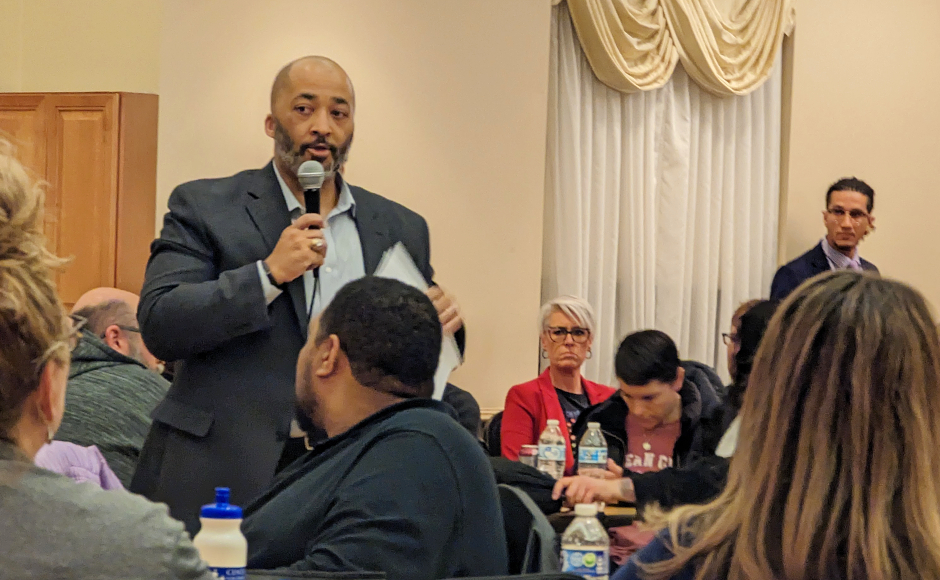
Collingswood Superintendent Fredrick McDowell addresses a community meeting about racial tensions in the district in 2023. Credit: Matt Skoufalos.
Conflicting accounts
McDowell said his attempts to collaborate with the borough municipal government on the bond issue have been rebuffed.
The superintendent described attempting to present Maley with the plans in a March 4, 2024 meeting, ahead of the March 9 board retreat, “and he wasn’t interested in talking.
“I got not even halfway through, and he didn’t want to hear anything else about it,” McDowell said.
“He didn’t want to see what the plan was; he didn’t want to see the numbers. He wasn’t interested in discussing it further because he didn’t believe that the board and the borough were in direct partnership.”
Whether current zoning laws would protect Good Shepherd from another form of commercial redevelopment, the superintendent said that in his conversations with the diocese, neither the church nor its community were interested in demolishing the church and school for housing.
“We were in active negotiation with them for six to seven months,” McDowell said. “They wanted to keep their church.
“The relationship with the school district would maintain their church, shared parking, shared site utilization, and the community-facing piece that they wanted to be maintained.”
McDowell also spoke on the interrelationship among the social, emotional, and academic needs of the district and the limitations of its physical space.
For a start, he said, despite the current setup of neighborhood elementary schools, 30 percent of all kindergarten-to-fifth-grade students in Collingswood don’t attend the school closest to their home address.
For another, he added, student achievement gaps at Sharp Elementary illustrate academic inequities in the current class groupings.
“There are some students that we are serving quite well, but there are a number of students that we are not serving with the current configuration,” the superintendent said.
“It is a moral and ethical imperative in a school district that if I have one classroom of third-graders that is 7 percent proficient in math and, half a mile away, they are 65 percent proficient in math, I have to do something about it,” he said.
“We’re talking about ensuring that artificial barriers that prevent all students from getting what they need to meet the standard are removed,” McDowell said. “We do not have a structure that is conducive to being able to do that.
“This is not a black or white issue,” he continued. “This is a socioeconomic issue; this is an access to resources issue. This has been a pervasive academic problem for many, many years. We are asking our community to make strategic investments.”
Kaiden also spoke about the challenge for the district not being its interest in or financial wherewithal to acquire the Good Shepherd building, but also the statutory work necessary to comply with New Jersey Administrative Code for educational facilities (NJAC 6A:26), which states:
To qualify as a school facilities project, the project must be new construction to meet the housing needs of unhoused students, or rehabilitation to keep a school facility functional for its original purpose or for a new purpose accomplished within the gross square footage of the original building. Maintenance projects intended solely to achieve the design life of a school facility and routine maintenance do not constitute school facilities projects.
The language of that statute sums up the challenge for the district in needing to close some of its current facilities in order to acquire, renovate, and reopen Good Shepherd as a town-wide upper elementary (fourth- and fifth-grade) school.
In short, to acquire a newer educational space, the district must show a deficit in seats. Its plan would reassign students from Sharp and Garfield Elementaries, adding 126 to Zane and 300 to Good Shepherd, while netting 80 new seats.
“We have been very clear about this from the first public presentation on that we are not allowed to just say, ‘We would like to buy Good Shepherd; let us do it,’” the board president said. “The math ends up being that you have to show you’re losing the number of seats that Good Shepherd gains you by decommissioning buildings.”
According to the assessment from Garrison Architects and Remington and Vernick Engineers, Zane North is the easiest elementary school to add classroom space, and Mark Newbie is the second. Neither can add classrooms with height because of their flat roofs, but each has physical space to add new, one-story wings.
Garrison recommended decommissioning the Sharp and Garfield elementary schools, “mainly because of the age of those buildings, the cost to make them ADA-compliant is quite high,” Kaiden said.
“The bottom line is, if we wanted to hold onto them as school places, they’d have to be torn down and rebuilt,” she said. “A new school building is at minimum $30 million. Good Shepherd is a ‘deal’ because it only costs $12 to 13 million to get up and running.”
No easy pathway to funding restoration
As to Maley’s contention that the district would be better served pitching an operations referendum to close its funding shortfall, such a referendum would be about three times as expensive as the capital bond question without resolving any of the issues it is intended to address, Coleman said.
Were the borough to follow the path charted by Robbinsville, Coleman said the outcome is uncertain.
She fears that doing the same in Collingswood could invite further cuts in state aid, worsening its budget challenges.
“We don’t know what’s going to happen with Robbinsville,” she said. “What they did was brilliant, but it comes with risk. They could get their budget cut next year from the state because they went around the law.”
According to the School Funding Reform Act (SFRA), Collingswood raises about $18.7 million of its school revenues from local levies, but its local fair share is $24.35 million. The district cannot raise enough money to narrow that difference within the statutory, 2-percent budget tax cap; even taxing to the limit of that 2 percent could only increase taxes about $374,000 annually.
Were the district to seek a referendum to make up the $5.65 million difference, its approval would raise taxes about $1,191 for a home assessed at the borough average value (about $235,000), Coleman said.
Similarly, a referendum seeking to recover the $3.69 million Collingswood was shorted in its adequacy calculations would add about $800 annually, permanently, to the average local household tax burden, Coleman said.
“That would be an immediate and permanent hit to their taxes just to close the gap,” she said; “not to do anything new.”
For Coleman, who’s never seen the district raise taxes more than $150 per average household in a single year during her term in Collingswood, “those are big numbers.”
“Both numbers show that Collingswood is close to fully funded, and the town’s ability to pay is much greater than what we ask for,” the assistant superintendent said. “What’s in dispute is how we go about asking for it.
The district has asked residents to help lobby state lawmakers to close the funding gap with some other mechanism, or to adapt the formula in SFRA to ease the extent of the disparity.
Alternatively, Collingswood could put its entire school budget to the community for an up or down vote annually, and hold separate school board elections — a process that the 2-percent-cap legislation sidesteps by limiting costs fundamentally.
“If we wanted to go above the 2 percent, we would have to move our [school board] election from November to April, and go back to the way we used to do budgets,” Coleman said. “They say yes or no, and if it’s a defeated budget, it has to get cut. Most districts stay in November.
Comparatively, the estimated local cost of the proposed $39.98 million bond referendum would add some $420 to $480 annually for a home assessed at the borough average over a 30-year period. The district is still paying off its 2005 bond referendum, with $7.8 million currently outstanding, which Coleman said will be retired by 2030.
“We have a budget situation, just like every school district in the state,” Coleman said, “but let’s not cloud the issue. We have real building needs, and this bond referendum is meant to address them.”

